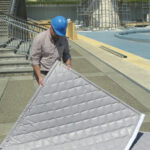Acoustic fabrics can be hung on walls or ceilings, or they can be used to make acoustically-transparent furniture and panels. There is a variety of acoustic fabrics color chart available on the market, and each type has its own benefits and drawbacks. When choosing an acoustics fabric, it is important to consider the specific needs of the space. For example, some fabrics are better at absorbing high frequencies, while others are more effective at absorbing low frequencies. communication clarity.
 |  |  |  |
| 538 Silver Papier | 130 Wheat | 460 Buff | 748 Bone |
 |  |  |  |
| 394 Opal | 481 Pearl | 404 Apricot Neutral | 7474 Straw |
 |  |  |  |
| 238 Grey Mix | 758 Desert Sand | 751 Terra | 403 Vanilla Neutral |
 |  |  |  |
| 298 Medium Gray | 750 Cement Mix | 422 Cinnabar | 423 Pumice |
 |  |  |  |
| 380 Quartz | 406 Silver Neutral | 539 Bleu Papier | 749 Dune |
 |  |  |  |
| 400 Cherry Neutral | 405 Lavender Neutral | 401 Blue Neutral | 757 Stream |
 |  |  |  |
| 390 Rose Quartz | 752 Lilac | 175 Crystal Blue | 755 Leaf |
 |  |  |  |
| 475 Sienna | 753 Violet | 150 Wedgewood | 754 Light Moss |
 |  |  |  |
| 468 Eucalyptus | 549 Chrome Green | 486 Bayberry | 545 Bronze |
 |  |  |  |
| 561 Verte Papier | 381 Aquamarine | 424 Amethyst | 556 Deep Burgundy |
 |  |  |  |
| 402 Green Neutral | 756 Lake | 153 Baltic | 418 Claret Accent |
 |  |  |  |
| 467 Blue Spruce | 470 Ultramarine | 553 Blue Plum | 408 Black |

